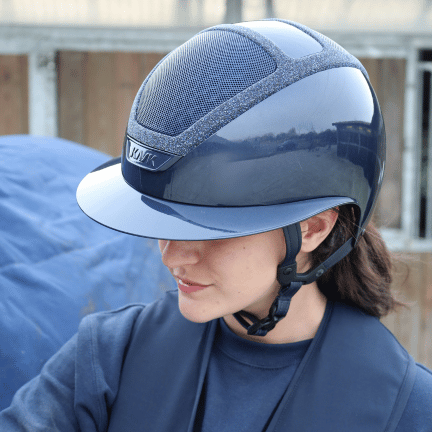A helmet is an essential piece of safety gear for every rider. Whether you're just starting out or an experienced equestrian, it protects your head from impact during falls while ensuring maximum comfort for an enjoyable ride. From selection to adjustment and maintenance, explore our expert advice to stay well-protected.
1. How to choose your helmet?
The first step in selecting a helmet is ensuring it meets current safety standards (CE VG1, ASTM, SEI). At Vestride, you can rest assured that all our helmets comply with these regulations.
Some helmets, however, provide enhanced head protection. This includes helmets with MIPS (Multi-directional Impact Protection System), an advanced technology that guards against rotational impacts. Others are meticulously designed to cover a larger portion of the head, like the Voronoi helmet by Freejump.
Most riders choose helmets based on aesthetic preferences. Beyond being protective gear, helmets have become an integral part of a rider's look, carefully selected and proudly worn.
But aside from style, other criteria can help you find the perfect helmet for your needs:
- Comfort: You’ll spend hours with your helmet on, so it’s crucial that it’s comfortable and free from painful pressure points.
- Adjustment System: Helmets with adjustable dials are particularly popular for children, allowing the fit to adapt as they grow.
- Visor Size: Long visors, which shield riders’ eyes from the sun and rain, are increasingly sought after.
- Chin Strap: Flexible or firm, the chin strap should be chosen based on the level of comfort and support you require.
- Ventilation System: Helmets with efficient airflow reduce sweating, especially during long or intense rides.
A comfortable helmet encourages consistent use.
2. How to adjust your helmet?
Your helmet should sit snugly on your head, protecting your forehead and staying well-centered. It should not slip over your eyes or tilt too far back.
Ensure it fits your head size without being overly tight. If you feel painful pressure points, the helmet is likely too small. Shake your head gently forward, backward, and side-to-side; the helmet shouldn’t shift significantly. If it does, it’s too large.
To check proper shell depth, you should be able to fit one or two fingers between the helmet and your eyebrows. If the gap is wider, the helmet may be too small; if smaller, it could be too large.
Selon le modèle, vous pouvez changer la mousse intérieure pour l’ajuster correctement à votre tour de tête, ou le régler grâce à sa molette de réglage.
Les sangles de la jugulaire doivent encadrer les oreilles sans les couvrir. Fermée, elle doit être proche du menton sans serrer ni gêner les mouvements ou la déglutition. Le système de réglage de la jugulaire ne doit pas vous causer de points de pression désagréables. À l’inverse, elle ne doit pas être trop lâche, au risque de ne pas vous protéger.

How can I find out my helmet size?
To find out your size helmet, measure your head circumference. To do this, use a flexible tape measure and place it around your head, about 1 to 2 cm above your eyebrows and just above your ears. Make sure the tape measure is straight and resting on the widest part of your head.
3. How to store and maintain your helmet?
The protective cover provided with most helmets shields against dust and dirt but doesn’t guard against impact. For optimal protection from minor knocks, opt for a padded helmet bag.
Once a helmet experiences an impact, its protective capacity diminishes. Micro-cracks invisible to the eye can weaken the shell, rendering it less effective at absorbing future shocks. This applies to riding accidents as well as everyday mishaps like dropping the helmet or handling it roughly. A padded bag absorbs these minor impacts, keeping your helmet in peak condition.
To keep your helmet clean and looking its best, regular maintenance is key. A damp cloth or soapy water typically suffices for removing saliva, mud, and dust. A microfiber cloth works well for dusting. For deeper cleaning, use a shell-cleaning product that leaves no greasy residue or streaks.
The inner padding, in direct contact with your head, accumulates impurities like sweat, dust, and makeup. Combined with body heat, these can promote bacteria and odors. Regular cleaning is essential.
If your helmet has removable padding, wash it in the machine following the manufacturer’s instructions. For non-removable liners, specialized cleaning products are available to disinfect and refresh the fabric.
4. When should you replace your helmet?
After a fall, we strongly recommend replacing your helmet—even if no visible damage is apparent. Its internal components may have absorbed the impact, reducing their protective capability for future incidents.
Without a fall, it’s advisable to replace your helmet every five years. Materials and components degrade over time, potentially compromising its integrity—especially with frequent minor impacts.
The lifespan of a helmet depends on its usage and care. Regular inspections are advised to ensure there are no cracks, deformations, or other damage.
For safety reasons, Vestride strongly discourages reselling old helmets when upgrading to a new model, even if the helmet hasn’t experienced a fall.
Our team of experts is here to help you choose the perfect gear and answer all your questions. Your safety and satisfaction are our top priorities.
